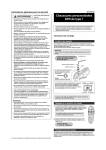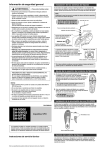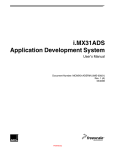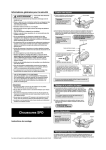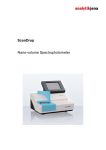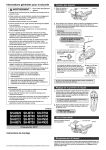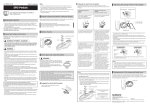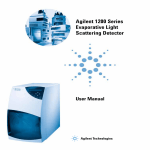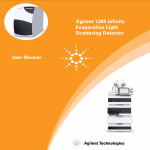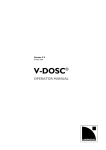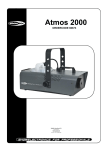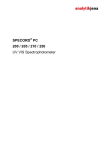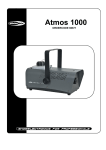Download "user manual"
Transcript
contrAA® 300 Continuum Source Atomic Absorption Spectrometer Analytik Jena AG Kundendienst Konrad-Zuse-Str. 1 07745 Jena Phone: e-mail: Hotline: + 49 (3641) 77-7407 Fax: + 49 (3641) 77-7449 [email protected] General information about Analytik Jena AG on the internet: http://www.analytik-jena.de Copyrights and Trademarks Microsoft, Windows 2000, Windows XP, Windows NT, MS Excel are registered trademarks of Microsoft Corp. Publication No.: 160:002.23 Edition – October 2005 Technical documentation made by: Analytik Jena AG This documentation describes the state of this product at the time of publishing. It need not necessarily agree with future versions of the product. Subject to change! © Copyright 2005 Analytik Jena AG Contents Contents ® 1 Basic information ....................................................................3 1.1 1.2 User manual conventions................................................................................3 Intended use....................................................................................................3 2 Safety instructions...................................................................5 3 Specifications ..........................................................................9 3.1 Technical data .................................................................................................9 3.1.1 3.1.2 3.1.3 3.1.4 contrAA 300.................................................................................................................9 Control computer .......................................................................................................11 Flame technique ........................................................................................................11 Accessories ...............................................................................................................12 3.2 Guidelines and standards..............................................................................14 4 Installation requirements ......................................................15 4.1 4.2 4.3 4.4 4.5 Ambient conditions ........................................................................................15 Floor space requirements and weight ...........................................................16 Energy supply................................................................................................16 Gases used in flame mode............................................................................17 Laboratory fume hood ...................................................................................18 5 Functions and design of the contrAA 300 ...........................19 5.1 Basic unit .......................................................................................................19 5.1.1 5.1.2 5.1.3 Physical measuring principle of HR-CS AAS.............................................................19 Xenon lamp ...............................................................................................................21 Flame system ............................................................................................................22 5.2 Accessories for flame technique ...................................................................25 5.2.1 5.2.2 5.2.3 5.2.4 AS 51 S and AS 52 S Autosamplers .........................................................................25 JUN-AIR 6/S Piston Compressor...............................................................................26 SFS 6 Injection Module .............................................................................................27 Scraper – Automatic burner head cleaner for nitrous oxide flame .............................28 5.3 Supplementary accessories – Hg/hydride systems ......................................28 6 Installation and start-up ........................................................29 6.1 6.2 6.3 Supply and control connections ....................................................................29 Installation and start of ASpect CS software.................................................31 Flame technique ............................................................................................32 6.3.1 6.3.2 6.3.3 6.3.4 Installation for manual sample supply........................................................................32 Installation for continuous operation mode / sample supply by autosampler .............34 Installation of the SFS 6 Injection Module .................................................................36 Change of burner head..............................................................................................37 6.4 Start-up of contrAA® 300 with accessories....................................................38 6.4.1 6.4.2 Turn-on sequence, daily start of work........................................................................38 Shutdown sequence ..................................................................................................38 7 Care and maintenance...........................................................39 7.1 7.2 Maintenance overview...................................................................................39 Basic device ..................................................................................................40 7.2.1 7.2.2 Fuse change..............................................................................................................40 Cleaning the sample compartment ............................................................................41 7.3 7.4 7.5 Xe lamp cooling .............................................................................................41 Removing and installing the continuum source (Xe lamp) ............................41 Burner-nebulizer system ...............................................................................43 Operating manual contrAA 300 10/2005 Analytik Jena AG 1 Contents 2 7.5.1 7.5.2 7.5.3 7.5.4 7.5.5 7.5.6 7.5.7 Disassembling the burner-nebulizer system ............................................................. 44 Cleaning the burner .................................................................................................. 45 Cleaning the nebulizer .............................................................................................. 46 Cleaning the mixing chamber ................................................................................... 46 Cleaning the siphon .................................................................................................. 47 Changing the impact bead ........................................................................................ 47 Assembling the burner-nebulizer system .................................................................. 48 8 Relocating the contrAA® 300................................................ 51 8.1 8.2 Preparing the contrAA 300 for relocation ..................................................... 51 Setting up the contrAA 300........................................................................... 51 9 Disposal ................................................................................. 53 ® Operating manual contrAA 300 10/2005 Analytik Jena AG Basic information User manual conventions 1 Basic information 1.1 User manual conventions The following warning and information symbols are used in this manual: Danger! To be followed strictly to prevent physical injury. Danger! Hot surface! Touching hot surfaces may cause burns. Hazardous electrical voltage; do not touch! Emission of UV radiation! Explosion hazard, fire hazard. Caution! To be followed to avoid damage to the equipment. Note To be followed to obtain correct measurement results. The manual uses the following conventions: 1.2 • Chapters and illustrations are numbered consecutively. • Every illustration has its own caption. • Instructions for actions/steps of operation are numbered consecutively and united in action units. • Menu and option sequences in software are subdivided by "/" and printed in bold letters, e.g. File / Open. Buttons or keys are marked by square brackets, e.g. [OK]. Intended use The contrAA® 300 Atomic Absorption Spectrometer is a PC-controlled device for the sequential trace analysis of metals and non-metals in liquid and dissolved samples. The contrAA® 300 is a flame device providing the possibility to use the hydride technique in combination with the Hydride System (HS) accessory. Used together with an autosampler, the contrAA® 300 can be used as automatic multielement analyzer in routine analysis. First, the system is to be calibrated sequentially for the elements to be analyzed. Then, the samples are measured sequentially. Thus, after every sample measurement, the results of all elements to be determined are available. All spectrometer parameters, burner height and fuel gas settings, are set automatically according to the stored method parameters, which may vary for the different element lines. The complete system, i.e. basic device and accessories, and data acquisition and analysis, are controlled by the Windows-based control software. The analytical background is also determined automatically and simultaneously at the analysis line. ® Operating manual contrAA 300 10/2005 Analytik Jena AG 3 Basic information Intended use The control software contains default parameters for methodical settings of an analysis line. The pre-defined line parameter settings for all analyzable elements of the periodic system (also called cookbook) make it easier to get started with analysis. Besides, they can be used as a basis for user-defined multielement analysis methods. The control software contains comprehensive presentation and storage options for measured signals and parameters, GLP-compliant result records and various options for quality control including the possibility of keeping quality control cards. 4 ® Operating manual contrAA 300 10/2005 Analytik Jena AG Safety instructions 2 Safety instructions For your personal safety and for the troublefree and safe operation of the contrAA® 300, read this section carefully before starting it up. Follow all safety instructions given in this manual and pay attention to all messages and notes displayed on the screen by control software. In addition, follow the safety instructions for system components of other manufacturers (e.g. PC, printer, autosampler) supplied together with the device. In particular, read and follow the safety notes given on the labels of reagents and the information on their handling, storage and disposal. Intended use! The contrAA® 300 may only be used for the techniques of atomic absorption spectrometry described in this manual. Local regulations! Comply with the local safety regulations relevant to the operation of the device (e.g. occupational safety regulations, accident prevention regulations). References to potential hazards made in this manual do not replace the relevant occupational safety regulations to be complied with. Personnel! The contrAA® 300 may only be operated by qualified persons who have been additionally trained for this type of work and have familiarized with the information given in this manual and in the accompanying manuals of accessories and system components. Any work on electrical equipment may only be performed by qualified and approved electricians. Explosion and fire protection The contrAA® 300 must not be operated in explosion-risk environments. Smoking is not allowed in the operating room of the contrAA® 300. The operator is responsible for establishing a control regime that ensures that nitrous oxide and acetylene connections are leak-proof. Device switch-off in emergency situations! Switch off the contrAA® 300 with the power switch on the right side panel. Disconnect the power cable from the power outlet. Switch off installed system components with the power switch of the connected multiple socket outlet, which should be placed in a way to allow fast access. Caution! In doing so, there is the risk of data loss and damage to the operating system on the PC! ® Operating manual contrAA 300 10/2005 Analytik Jena AG 5 Safety instructions Electric shock! The contrAA® 300 is powered by electrical voltage. Extremely hazardous electrical voltages are applied to several components in the system! To ensure Protection Class I (protective earth connection) of the device, connect the power plug of the device only to a power outlet with protective earth conductor. The protective effect must not be undone by the use of an extension cable without protective earth conductor. For any work on the electrical equipment, make sure to switch off the contrAA® 300 and disconnect the power cable from the power outlet. Only service technicians of Analytik Jena AG and authorized specialists are allowed to remove the back panel of the device. Only service technicians of Analytik Jena AG and specially qualified electricians are allowed to open system components, particularly the housing of the xenon lamp. Operating materials, hazardous substances The operator is responsible for the selection of the substances used in the process as well as for their safe handling. This applies, in particular, to radioactive, infectious, toxic, corrosive, combustible, explosive and otherwise hazardous substances. In handling hazardous substances, comply with the relevant local safety regulations and guidelines. Always observe the notes given on labels. Always use labeled vessels, protective goggles and rubber gloves. The contrAA® 300 may only be operated under an active laboratory fume hood to withdraw ozone, combustion gases of samples, and toxic and combustible byproducts of sample preparation. Treat biological samples in compliance with the relevant local regulations for the handling of infectious material. The operator is responsible for disposing of waste material, such as filter residues of the compressor, in an environmentally conscious manner and in compliance with the relevant local regulations. Combustible and explosive gases Be careful if acetylene is escaping! Acetylene is an explosive gas that is easily detected by its smell. Shut down the contrAA 300 if gas paths are leaking and fuel gas valves or safety devices of the automatic gas control system are defective. Keep vessels holding combustible solvents or samples containing volatile and combustible substances away from the flame. Xenon lamp and lamp housing Inside the quartz bulb of the xenon lamp, there is an overpressure of 2 MPa, which may increase up to 7 MPa in operation! Only service technicians employed with or authorized by Analytik Jena AG are allowed to open the lamp housing. 6 ® Operating manual contrAA 300 10/2005 Analytik Jena AG Safety instructions UV radiation and dazzling hazard Protect your eyes! Never look at the radiation of the xenon lamp or the burner flame without wearing UV protective goggles. In flame mode, always keep the door of the sample compartment closed while the flame is ignited. The xenon lamp, in particular, emits very intense light in the visible and UV region! Ozone Inadmissibly high toxic ozone concentrations are produced by the interaction of the UV radiation of the xenon lamp and the N2O burner flame with the ambient air. The contrAA® 300 may only be operated under an active fume hood. Operation of high-pressure gas cylinders and gas plants Fuel gas and oxidant are supplied by high-pressure gas cylinders or local gas plants. Make sure to fully comply with the local safety regulations and guidelines relevant to the operation of high-pressure gas cylinders and gas plants. High-pressure tubes and pressure-reducing valves may only be used for the specified gases. Keep supply tubes, fittings and pressure-reducing valves for N2O (nitrous oxide) free from grease. Weekly perform leak tests of all gas connections including nebulizer and mixing chamber. Carefully ventilate the cylinder location after having replaced the gas cylinder. High temperatures In flame mode, high temperatures are generated. Allow for appropriate cooling times! Do not touch hot components during or directly after measurements. Allow for appropriate cooling times before undertaking maintenance or replacing such components as burner head and lamps. Keep combustible materials away from the device. Ventilation Take care to ensure that the ventilation systems on the contrAA® 300 and the accessory units are always functional. Covered vents, ventilation slots, etc. may result in malfunction or damage to the device. Cleaning and maintenance Except for the work described in Section "Care and maintenance" p. 39, service, maintenance and repair work on the contrAA® 300 may only be carried out by service technicians employed with or authorized by Analytik Jena AG. Non-compliance involves the risk of misalignment or damage to the device. ® Operating manual contrAA 300 10/2005 Analytik Jena AG 7 Safety instructions To externally clean the contrAA® 300, only use a slightly moistened, but not dripping cloth. For cleaning in the sample compartment of the contrAA® 300, take suitable precautions, especially for the protection against contaminated and infectious materials. Flame mode Do not use pure oxygen or air enriched with oxygen as oxidant. Ensure that the flame sensor is always functional. If gas paths are leaking, or if detect a fault on the fuel gas valves or the safety devices of the automatic gas control system, switch off the contrAA® 300 until the fault has been remedied. Use the acetylene cylinder only in an upright position and secured against falling over. When the cylinder pressure drops below 100 kPa, replace the cylinder to prevent acetone from entering the automatic gas control system. Keep vessels holding combustible solvents and samples containing volatile, combustible constituents away from the flame. Ignite and operate the flame only with the sample compartment door being closed. Never leave burning flames unattended. The nebulizer pressure must not drop below 70 kPa. When carrying out maintenance work on the nebulizer/burner system, clean all contaminated parts. Sensitive electronics Always electrically connect and disconnect any system components to the contrAA® 300, when they are switched off. This also applies when electrically connecting system components with each other. 8 ® Operating manual contrAA 300 10/2005 Analytik Jena AG Specifications Technical data 3 Specifications 3.1 Technical data 3.1.1 contrAA 300 Optical system Reflecting optics with protective coating and optical system in light-proof casing Monochromator Optimized high-resolution Echelle double monochromator. Pre-monochromator with quartz prism. Wavelength accuracy ensured through automatic neon wavelength correction Wavelength range 190 – 900 nm Spectral band width 2 pm at 200 nm Grating Echelle grating Optical bench encased photometer Optics mounted to solid base plate for stability and robustness. Protection against humidity and waste gas. Detector CCD line detector with high quantum efficiency and increased UV sensitivity Lamp Xenon short-arc lamp with UV arc in hot spot mode; automatic hot-spot tracking; simultaneous drift correction Lamp current 9-16 A / 7 A Stand-by mode Operating mode electrically modulated at 50 Hz Power supply Power supply unit integrated in spectrometer Display modes Absorption 0 … 3.99 Concentration Range of values: 5-place (0.001 … 99999), freely selectable unit Energy 0 - 60000 counts Signal analysis ® Time resolved Mean value, maximum value of absorption, integral of absorption Spectrally resolved Spectrum with 50 to max. 200 pixels Operating manual contrAA 300 10/2005 Analytik Jena AG 9 Specifications Technical data Power supply Power requirements Frequency 110 - 230 V ±10 % 50/60 Hz Other line voltages and frequencies on request In-house line fuse protection, 16 A slow-blow installation side Power consumption Basic unit: Basic unit with PC, monitor and AS 52 Autosampler: Overvoltage Category II acc. to DIN EN 61010-1 Pollution degree 2 acc. to DIN EN 61010-1 Protection Class I Degree of protection IP 20 460 VA 650 VA When connecting components to the output socket additional to PC and monitor, there is the risk of exceeding the admissible limit value of leakage current. Instrument fuses Miniature fuses (5×20 mm) acc. to IEC 60127. Line power input F1, F2 T 10 A/H XE power supply F3, F4 T 3.15 A/H Ambient conditions Corrosion protection Device is corrosion-proof against the samples to be analyzed Operating temperature +10 °C to 35 °C Humidity Max. 90 % at +30 °C Storage temperature (desiccant) –40 °C to +50 °C acc. to DIN 58390-2 Dimensions and weights 10 Weight 90 kg Dimensions (W x H x D): 890 mm × 450 (540) mm × 545 mm ® Operating manual contrAA 300 10/2005 Analytik Jena AG Specifications Technical data 3.1.2 Control computer 3.1.3 Computer (minimum requirements) PC Pentium 1 GHz with 512 Mbyte RAM 40 Gbyte hard disk, 43-cm color monitor (17") VGA graphic card Resolution 800x600 Pixel or higher , CD ROM Ports: – Mouse port – Printer port - USB port (USB 1.1 or 2.0) for contrAA® 300 Printer HP DeskJet Ink Jet Printer HP Laser Jet Laser Printer Operating system Windows XP Professional Flame technique Flame types Acetylene/air Single-slot burner 50 mm, coded (standard) Single-slot burner 100 mm, coded (optional) Acetylene/nitrous oxide Single-slot burner 50 mm, coded Oxidant Compressed air and N2O (nitrous oxide) Inlet pressure: Nebulizer flow rates Air N2O 400 to 600 NL/h 320 to 480 NL/h Auxiliary oxidant (air or N2O) 30 to 315 NL/h Total oxidant Air N2O 400 to 700 NL/h 320 to 700 NL/h 300 to 600 kPa Fuel gas Acetylene ® Operating manual contrAA 300 10/2005 Analytik Jena AG Inlet pressure: Consumption: 80 to 150 kPa 40 to 315 NL/h 11 Specifications Technical data Nebulizer Operating principle Pneumatic concentric jet nebulizer Material Platinum/Rhodium tube, PEEK nozzle, PEEK cap Nebulizer 0.7 Flow rate 4 to 7 mL/min Siphon monitoring Operating principle Float, corrosion-proof Burner adjustment Height 4 to 16 mm, automated Rotation 0 to 90 degrees, manual Safety circuits Monitoring 3.1.4 Burner and burner type Fuel as pressure Oxidant pressure and flow rate Siphon fill level Flame Oxidant inlet pressure (air and N2O) Fill level of waste bottle Accessories Autosampler AS 51 s Autosampler without dilution function, completely PC-controlled 12 Sample tray 87/15 Sample cups Special cups 77 (15 mL) 10 (30 mL) Sample tray 49/30 Sample cups Special cups 39 (30 mL) 10 (30 mL) Power supply via spectrometer Wash bottle 2L Weight 5 kg ® Operating manual contrAA 300 10/2005 Analytik Jena AG Specifications Technical data Autosampler AS 52 S Autosampler with dilution function, completely PC-controlled Sample tray 87/15 Sample cups Special cups 77 (15 mL) 10 (30 mL) Sample tray 49/30 Sample cups Special cups 39 (30 mL) 10 (30 mL) Injector 5 mL Power supply Via spectrometer Wash bottle 2L Diluent bottle 2L Weight 9 kg Injection Module SFS 6 PC-controlled Sample volume for single analysis 300 µL (minimum volume) Power supply Via spectrometer Piston Compressor JUN-AIR 6/S Standard ® Tank capacity 15 L Dimensions (diameter × height) 400 mm × 480 mm Power supply 230 V, 50 Hz Weight 28 kg Operating manual contrAA 300 10/2005 Analytik Jena AG 13 Specifications Guidelines and standards 3.2 Guidelines and standards Protection Class and Degree of Protection The contrAA® 300 is classified in Protection Class I. The Degree of Protection of the casing is IP 20. Device safety The contrAA® 300 complies with the following safety standards • DIN EN 61010-1 (VDE 0411T.1; IEC 1010-1) • DIN EN 61010-2-061 (IEC 1010-2-061) Electromagnetic Compatibility (EMC) The contrAA® 300 has been tested for radio interference suppression and noise immunity. It complies with the requirements of • DIN EN 61326 EC Directives The contrAA® 300 has been manufactured and tested in compliance with standards that meet the requirements of EC Directives 73/23/EEC and 89/336/EEC. The device was delivered in perfect, technically safe condition. To maintain this condition and ensure safe operation, observe the safety and operating instructions given in this manual. In addition, observe the operating instructions supplied along with accompanying accessories and system components of other manufacturers. 14 ® Operating manual contrAA 300 10/2005 Analytik Jena AG Installation requirements Ambient conditions 4 Installation requirements The device may only be set up, installed and repaired by service technicians employed with or authorized by Analytik Jena AG. Any unauthorized tampering with the device will limit the rights to claim under warranty. To set up the device, an assistant will be needed temporarily. The service technician will test the device and record the test in the test report of the contrAA® 300. The operator of the device is responsible everything not included in the scope of delivery of the contrAA® 300, but needed for its operation. The operation of the contrAA® 300 necessitates that certain technical requirements be met: • Suitable installation site • Sufficient floor space • Ambient conditions • Supply of fuel gas and oxidant • Laboratory fume hood • Mains connection Pay attention to the instructions given in Section "Safety instructions" p.5. See to it that occupational safety regulations are complied with. References to potential hazards do not replace the valid occupational safety regulations! Potential hazards when working with the contrAA® 300 include: 4.1 • Burn hazard by flame and hot burner components • Hazard from electric current • UV radiation hazard • Hazard from the generation of ozone and nitrogen oxides • Hazard in handling high-pressure gas cylinders • Hazard from toxic and chemically aggressive substances Ambient conditions ® • Do not set up the contrAA® 300 directly beside a door or window. The installation site of the contrAA® 300 should be free of draft, dust, corrosive vapors and vibrations. • Do not set up the contrAA® 300 near sources of electromagnetic interference. • Avoid direct exposure of the contrAA® 300 to sunlight and radiation from heaters. In extreme cases, provide room air conditioning. • You are advised to prepare samples and store wet-chemical materials in a separate room. • In the operating room of the contrAA® 300, smoking is not allowed. • Operating temperature range: Operating manual contrAA 300 10/2005 Analytik Jena AG +10 °C to 35 °C 15 Installation requirements Floor space requirements and weight 4.2 • Storage temperature range -40 °C to 55 °C, use of a desiccant. • Operating humidity max. 90 % bei 30 °C • Storage humidity 10 % to 30 %, use of a desiccant Floor space requirements and weight • Minimum size of work bench: 1880 mm × 700 mm, height to be selected according to ergonomic aspects • Carrying capacity of work bench: 120 kg • Bench surface quality: wipe-proof, scratch-proof and corrosion-proof, not moisture-absorbing Set up the work bench to allow easy access from all sides. Component Width [mm] Height [mm] Depth [mm] Weight [kg] contrAA® 300 800 650 700 90 AS 51s 340 450 350 5 AS 52 S 410 500 350 9 On the work bench Under the work bench Compressor JUN-AIR 6/S ∅ 400 Table 4-1 4.3 480 28 ® Dimensions and weights of the contrAA 300 and its system components Energy supply Correct electrical mains supply! For the electrical installation, observe the relevant national and local regulations! The power outlet must be correctly earthed. Do not use an adapter in the mains supply line. Do not use any automatic circuit breakers. The contrAA® 300, PC, monitor and printer are to be connected to a power outlet via a common multiple socket outlet and thus to the same phase. To avoid abrupt voltage fluctuations, do not connect the contrAA® 300 to a circuit, to which other high energy consuming equipment has been connected. 16 ® Operating manual contrAA 300 10/2005 Analytik Jena AG Installation requirements Gases used in flame mode Line power requirements 4.4 Voltage 110/230 V ±10 % or other voltage as specified in Supply Contract Frequency 50/60Hz or other frequency as specified in Supply Contract Power consumption Basic device: 450 VA Basic device with PC, monitor and AS 52s Autosampler: 650 VA Fuse protection 16 A, slow blow Gases used in flame mode Operation in flame mode requires the use of an oxidant (compressed air and N2O, if necessary) and acetylene as fuel gas. The purity of the gas used is of crucial importance for the analysis. Compressed air supply is provided by the JUN-AIR 6/S Piston Compressor. If you intend to use an existing in-house compressed-air supply system, please consult the Service Department of Analytik Jena AG. N2O supply is via high-pressure gas cylinders or an in-house supply system. Installation of high-pressure gas cylinders If fuel gas supply is from high-pressure cylinders, the cylinders must be installed upright in gas cylinder cabinets or mounted to the wall with cylinder holders outside the laboratory room. The pressure gas tubes are supplied with the device, the pressure-reducing valves are optional. • Tube length for connection to cylinder 5m • Tube length for connection to compressor 5m On request, you may also use tubes of other lengths. If you intend to do so, please consult the Service Department of Analytik Jena AG. Fuel gas and oxidant Inlet pressure Consumption Compressed air, oil-free, grease-free, particle-free 300 to 600 kPa Max. 700 NL/h N2O, oil-free, grease-free, purity 2.5 300 to 600 kPa Max. 700 L/h Acetylene 80 to 150 kPa Purity 2,5 (for flame photometry): better than 99.5 Vol% relative to C2H2, without acetone. Minor constituents: Hydrogen compounds of As, S and P Table 4-2 ® Operating manual contrAA 300 10/2005 Analytik Jena AG Max. 315 NL/h Gases for flame technique 17 Installation requirements Laboratory fume hood 4.5 Laboratory fume hood Laboratory fume hood Do not operate the contrAA® 300 without fume hood! Direct waste gas to the outside and avoid blockage! The laboratory fume hood shall exhaust noxious combustion residues of the flame and any produced ozone. Ozone is produced by the interaction of air and the UV radiation emitted by the xenon lamp and the burner flame. The used fume hood should be made of material that is resistant to heat and corrosion. The first six meters of the fume hood should be made of metal. Parameters Properties Material V2A Exhaust capacity with nitrous oxide flame Approx. 8 to 10 m3/min Exhaust capacity with air flame Approx. 5 m3/min Hood opening Approx. 200 × 200 mm Distance to top edge of device Approx. 200 to 300 mm Tube diameter Approx. 100 to 120 mm Table 4-3 18 Laboratory fume hood requirements ® Operating manual contrAA 300 10/2005 Analytik Jena AG Functions and design of the contrAA 300 Basic unit 5 Functions and design of the contrAA 300 5.1 Basic unit 5.1.1 Physical measuring principle of HR-CS AAS The measuring principle of both High Resolution Continuum Source Atomic Absorption Spectrometry (HR-CS AAS) and classical Line Source AAS (LS AAS) is based on the absorption of primary radiation by the analyte atoms in their ground state. The measured absorbance signal constitutes a measure of concentration of the respective element in the analyzed sample. Every AAS device consists of the following basic modules: • Light source • Atomizer • Monochromator • Detector • Evaluation unit (PC) Emission (HCL) Emission (Xe) Absorption(Flame) Absorption(Flame) Monochromator (low resolution) Monochromator (high resolution) Detector (Photomultiplier) Signal of line source Fig. 5-1 Detector (CCD line) Signal of continuum source Schematic comparison of the physical measuring principles of LS AAS and HR-CS AAS Light source In HR-CS AAS, the element-specific light source of classical AAS (hollow cathode lamp (HKL)) is replaced by a single continuum source, a xenon short-arc lamp, which is used for all elements and lines. Due to the special electrode geometry of the xenon short-arc lamp, a hot arc spot (“Hot-Spot”) is caused that ensures very high radiation density and continuous emission throughout the entire spectral range (190 – 900 nm). This way, all analysis lines of interest are available without any restrictions and at any time – concerning both the resonance wavelengths of the elements to be analyzed and all secondary wavelengths without the technical limitations caused by specific properties of the HCL, such as exit window and emission intensity. In addition, ® Operating manual contrAA 300 10/2005 Analytik Jena AG 19 Functions and design of the contrAA 300 Basic unit absorption lines or bands of diatomic molecules (PO, CS, ...) can be used analytically for element determination. Atomizer Like in classical LS AAS, the atomizer used for the flame technique is a burnernebulizer system with a pneumatically aspirating nebulizer. For this reason, the sensitivities to be expected (characteristic concentrations) are in essence comparable. Monochromator The selectivity of the analysis is realized by a high-resolution double monochromator based on a prism and an Echelle grating monochromator. In this way, a very compact design and a high spectral resolution (high spectral dispersion of radiation) of λ/∆λ =145 000 is achieved, which corresponds to a spectral band width of < 2 pm per pixel at 200 nm. The monochromator is wavelength-stabilized by the use of an integrated neon source. The wavelength accuracy is achieved by monochromator calibration, when a wavelength is adjusted based on the physically defined neon lines. Prism CCD detector Echelle grating Xenon lamp Fig. 5-2 Flame ® Optical path in contrAA 300 Detector In place of the exit slit of the monochromator, which in classical LS AAS isolates the analysis line from other radiation emitted by the HCL before it reaches the detector, in HR-CS AAS a low-noise, UV-sensitive semiconductor detector is used (CCD line detector). This detector does not only detect the intensity on the analysis line, but also its spectral neighborhood. In this way, a spectral region of up to 1 nm around the analysis line is detected simultaneously and at a high resolution. 20 ® Operating manual contrAA 300 10/2005 Analytik Jena AG Functions and design of the contrAA 300 Basic unit Evaluation unit Background correction is by polynomial formation through selected reference points. The selection of these reference points may be performed manually by the user; by default, however, it is done automatically through software. The reference points are dynamically selected for every spectrum using a special algorithm and based on criteria ensuring approximation to the actual baseline on the measuring pixel that is as accurate as possible. If a fine-structured background overlaps the analysis wavelength, a multivariant method can be applied. To this end, reference spectra of matrix constituents are used for the polynomial forming least-squares fit. If atom lines directly overlap with the analysis wavelength, it is also possible to perform interelement correction (IEC). For this correction, spectral lines are used, which are adjacent to the interfering element and captured by the observation width of the detector (e.g.: correction of spectral interference of Fe at the analysis wavelength of Zn at 213 nm or Se at 196 nm). Lamp drift and all broad-band effects are instantly eliminated from the spectrum by automatic and simultaneous background correction with correction pixel assignment. In this way, a simultaneous double-beam system is realized with only one optical path, which results in clearly higher measurement stability compared to classical LS AAS. While the sensitivity of this technique is comparable to that of LS AAS, it features clearly improved signal-to-noise ratios and thus lower detection and determination limits. These are achieved by the use of the CCD line detector of the contrAA® 300 with extremely low noise compared to the photomultipliers customary in LS AAS and to the use of the high-energy xenon short-arc lamp with its very high light intensity. 5.1.2 Xenon lamp The continuum source used on the contrAA® 300 is a xenon short-arc lamp. Due to the special electrode geometry of the xenon short-arc lamp, a hot arc spot (“hot spot”) is formed that emits a very high radiation density throughout the entire spectral range (190 – 900 nm). During the analysis, the position of the arc spot is monitored and automatically readjusted. This way, warm-up effects by lamp drift are avoided. All drifts of the xenon lamp are simultaneously corrected for in the spectra through correction pixels. Fig. 5-1 ® Operating manual contrAA 300 10/2005 Analytik Jena AG Xenon lamp 21 Functions and design of the contrAA 300 Basic unit 5.1.3 Flame system Flame atomic absorption spectroscopy is used for the determination of trace elements in the concentration range from mg/L to µg/L and for the determination of principal components. The technique requires a flame with constant properties. The composition of the flame must be adjusted to the element to be analyzed. The device provides the motorized vertical adjustment of the nebulizer-mixing chamber-burner system by 12 mm thus making it possible to move the flame zone with the maximum absorption into the beam path. For the measurement of principal components, the burner head can be swiveled by 90° on the burner neck until it is at right angles to the beam thus shortening the absorption path of light through the flame. The sample solution is aspirated by a pneumatic concentric jet nebulizer and sprayed into the mixing chamber. In the mixing chamber, the sample aerosol is mixed with acetylene and auxiliary oxidant before it emerges from the burner slot. The flame is either 5 or 10 cm long and a few millimeters wide depending on the burner type used. The beam transmits the full length of the flame. 5.1.3.1 Automatic gas control system The automatic gas control system ensures acetylene and oxidant supply to the flame at defined flow rates and free from pressure fluctuations. It allows reliable and safe ignition and quenching of the flame. The automatic gas control system has three gas inlets for acetylene, air and nitrous oxide. The fuel gas flow is adjusted in 5-L steps between 40 and 315 NL/h acetylene via a proportional valve integrated in the control path. The air flow first fills the 600 cm³ gas tank, before it is released to the nebulizer. In both normal and emergency cases, the flame is quenched by an air flow coming from the tank. The oxidant flow through the nebulizer is defined by its setting and the admission pressure. If auxiliary oxidant is used, the total oxidant flow is regulated by a proportional valve in the auxiliary oxidant path (air or nitrous oxide). The fuel gas flow/total oxidant flow ratio is kept constant. The flame is ignited by an incandescent filament swiveled from the back wall of the sample compartment over the center of the burner. The flame can be switched from acetylene/air to acetylene/nitrous oxide by shutting off the air supply and opening the nitrous oxide supply and additionally increasing the acetylene flow. Quenching of the acetylene/nitrous oxide flame is in reverse order. 5.1.3.2 Burner-nebulizer system The nebulizer produces the aerosol of the sample solution needed for the atomization in the flame. The oxidant is supplied to the nebulizer through a lateral connector. It flows through the concentric jet formed by the corrosion-proof platinum-rhodium tube and the plastic nozzle made of PEEK. Sample solution is expelled from the tube and further sample solution aspirated by the produced negative pressure. The position of the tube end relative to the nozzle determines the aspiration rate and the aerosol output. It is manually adjustable by means of an adjusting screw and lock nut. The sample aerosol hits the impact bead, where larger droplets condense and then drain away through the siphon. The fuel gas flow hits the impact bead at right angles. The generated aerosol flows through the mixing chamber to the burner. On the way through the mixing chamber, equilibrium conditions are reached. Further large 22 ® Operating manual contrAA 300 10/2005 Analytik Jena AG Functions and design of the contrAA 300 Basic unit droplets condense on the wall of the chamber and drain away through the siphon. The aerosol containing smaller droplets is evaporated when entering the flame and then atomized in its hot zone. If the sample evaporates incompletely, the accuracy of the analytical result is adversely affected, as background absorption is increased by the scattering of radiation on unevaporated droplets. 1 2 3 4 5 6 7 8 9 10 11 12 13 14 Fig. 5-2 Auxiliary oxidant supply Fuel gas supply Oxidant supply Adjusting screw Sample liquid supply Lock nut Nebulizer Impact bead controls Impact bead Mixing chamber Siphon Siphon drain Float Burner Nebulizer-mixing chamber-burner system 5.1.3.3 Burner and flame type The contrAA® 300 can be operated with the following types of flames and corresponding burners: • Acetylene/air flame with 50-mm single-slot burner (standard burner) or 100-mm single-slot burner (sensitivity increases by a factor of 1.5 – 1.8 compared to the standard burner because of the longer absorption path) • Acetylene/nitrous oxide flame with 50-mm single-slot burner If the range of elements to be analyzed includes both elements that are easy to atomize and those hard to atomize, only the standard 50-mm single-slot burner should be used to avoid the need to change the burner between measurements. ® Operating manual contrAA 300 10/2005 Analytik Jena AG 23 Functions and design of the contrAA 300 Basic unit Use of the different flame types: • Acetylene/air flame can be used for most of the elements. • Acetylene/nitrous oxide flame is requited for elements that are hard to atomize, such as boron, aluminum and silicon. 1 50-mm single-slot burner (standard) 100-mm single-slot burner 2 Fig. 5-3 Burner types The burners are made of titanium and thus inert against aggressive sample solutions. The burners can be easily exchanged and continuously rotated up to 90° between two stops. One of the stops is adjusted in such a way that the burners are in alignment with the optical axis. The 90° stop ensures the insensitive position of the burner at right angles used for the determination of the principal components. 5.1.3.4 Sensors The burner-nebulizer system is monitored by various sensors that ensure operational safety. • A float switch in the siphon signals the correct fill level of 80 mm water column. • Two reflective couplers identify the burner type by means of a code. • A UV-sensitive sensor is used to monitor the flame. In addition to the above mentioned sensors, the mixing chamber is equipped with a pressure relief valve. This valve opens should the flame flash back into the mixing chamber. The control software evaluates the sensor signals and additionally monitors gas pressures, gas flow rates and the status of the flame. 24 ® Operating manual contrAA 300 10/2005 Analytik Jena AG Functions and design of the contrAA 300 Accessories for flame technique 5.2 Accessories for flame technique 5.2.1 AS 51 S and AS 52 S Autosamplers In the flame technique and the Hg/hydride technique, both manual and automatic sampling can be employed. Automatic operation and multielement analysis, however, are only possible if an autosampler is used. Parameter adjustment and function control of the autosamplers are via the contrAA® 300 control software. The contrAA® 300 can be operated in combination with the following autosamplers: • The AS 51 S autosampler only operates as sampler. • The AS 52 S autosampler additionally has a dilution function. Both autosamplers use sample trays of the same diameter. The following types of sample trays are available: 87 cup places Sample tray with 77 places for 15mL Sarstedt cups on the outer track and 10 places for 30mL-Sarstedt cups on the inner track 49 cup places Sample tray with 49 places for 30-mL Sarstedt cups The tray should be selected to meet the requirements of the specific sample analysis: • Available sample volume • Type of signal evaluation The sampling arm of the autosampler reaches all positions intended for sampling software controlled. The immersion depth of the uptake capillary in the sample and the special cups is preset, may however be varied via the control software. The autosamplers are powered via the contrAA® 300. The rotatable sample tray and the sampling arm are driven by stepper motors. The sampling arm is swiveling. Additionally, it can be lowered by 110 mm. On the top of the autosampler, a wash cup is located beside the tray and, on the AS 52 S, an additional mixing cup. A diaphragm pump delivers the washing liquid from the dispensing bottle into the wash cup. In this process, the immersed capillary is cleaned by external and internal rinsing. Excess washing liquid is drained into the waste container placed under the bench. ® Operating manual contrAA 300 10/2005 Analytik Jena AG 25 Functions and design of the contrAA 300 Accessories for flame technique 1 2 3 4 Fig. 5-4 Sampling arm Wash cup Mixing cup Dosing device 5 6 7 8 Dispensing bottle for diluent Dispensing bottle for washing liquid Sample cup Sample tray AS 52 S Autosampler, mounted to the sample compartment The AS 52 S Autosampler has a pipettor with a 5-ml dosing device. Dilution of standards or samples in the mixing cup is carried out as follows: The concentrate is filled in the mixing cup. Then, the diluent is added at a high dosing speed. Mixing is complete after a fixed waiting time. Residual liquid that is not aspirated by the nebulizer is evacuated by a second diaphragm pump into the waste container. The AS 52 S Autosampler with dilution function features the following advantages: 5.2.2 • Preparation of standards for the calibration by diluting one or several stock standards in the mixing cup • Dilution of the sample if its concentration is too high, i.e. its element content is higher than that of the calibration standard with the highest concentration • Dilution of all samples at freely selectable dilution ratios up to a ratio of 1:300. JUN-AIR 6/S Piston Compressor If no in-house compressed-air supply is available, it is useful to use a compressor that produces the air required for the acetylene/air flame. The JUN-AIR 6/S Piston Compressor is available as option. The produced compressed air is free from water, dust and oil. With a maximum operating pressure of 26 ® Operating manual contrAA 300 10/2005 Analytik Jena AG Functions and design of the contrAA 300 Accessories for flame technique 800 kPa and a 15-L air tank, the compressor meets the demands on compressed air supply. For its operation, observe the instructions given in the operating manual of the JUN-AIR 6/S Piston Compressor. 5.2.3 SFS 6 Injection Module SFS 6 Injection Module (Segmented Flow Star) is available as optional accessory. It may be used in combination with an autosampler or in manual mode. On the one hand, it allows washing or carrier solution to be aspirated continuously thus keeping the burner at a constant temperature by the aerosol; on the other hand, it allows small sample volumes to be measured reproducibly against a carrier solution (e.g. n-butanol). The operating principle of the SFS 6 Injection Module is based on a magnet with two inlets and one outlet to the nebulizer. The sample aspiration tube is located at the energized inlet. It is immersed directly into the sample or connected to the aspiration capillary of the autosampler. The non-energized inlet is connected to the aspiration tube for the washing or carrier solution. These are the two switching states: • Basic state: Sample path is blocked, while the carrier solution path is free • Active state: Sample path is free, the carrier solution path is blocked The parameters for controlling the SFS 6 Injection Module are entered via the control software. 1 2 3 4 5 Fig. 5-5 ® Operating manual contrAA 300 10/2005 Analytik Jena AG Support Tube to carrier solution Short piece of tube to nebulizer capillary Sample tube Control cable SFS6 Injection Module 27 Functions and design of the contrAA 300 Supplementary accessories – Hg/hydride systems 5.2.4 Scraper – Automatic burner head cleaner for nitrous oxide flame The Scraper, an intelligent burner head cleaner, is recommended for the continuous and fully automated operation with the nitrous oxide flame. When working with the nitrous-oxide flame and particularly the fuel-rich C2H2/N2O flame, as is used for the analysis of such elements as Si, W, Mo and Sn, graphite will deposit on the burner slot over longer periods. If these deposits are not removed completely, this will lead to clogging of the burner slot, which in turn will result in irreproducible measurement results. The square metal rod can be used as a manual aid for burner head cleaning. However, cleaning must not be carried out during a running measurement, and it requires the permanent presence of an operator. Using the scraper, the cleaning procedure can be fully automated. Once activated in software and stored as method parameter, the scraper guarantees a continuous and reproducible measuring process without any disturbances and interruptions. You can choose among various cleaning intervals depending on flame composition and need. On the other hand, the scraper can also be used for the automation of the burn-in process of the nitrous-oxide flame. If activated in the flame monitor, a cleaning step is carried out every 30 s. This way, undisturbed burning in of the nitrous oxide flame is possible. 1 2 3 Fig. 5-6 5.3 Scraper 50-mm burner head Scraper connection cable Scraper mounted to 50-mm burner head Supplementary accessories – Hg/hydride systems The Hg/hydride systems available for use with the contrAA® 300 are the HS60 and the HS60A. These systems are described in the separate operating manuals of the Hg/hydride systems. 28 ® Operating manual contrAA 300 10/2005 Analytik Jena AG Installation and start-up Supply and control connections 6 Installation and start-up No unauthorized tampering! The device may only be set up, installed and repaired by service technicians employed with or authorized by Analytik Jena AG. Any unauthorized tampering will limit the right to claim under warranty. For the installation and start-up of the device, the instructions given in Section 1 must be observed. Compliance with these safety instructions is a requirement for the trouble-free installation and functioning of your AAS measurement environment. Always observe all warning and information labels affixed to the device or displayed by the contrAA® 300 control software. To ensure trouble-free operation of the contrAA® 300 take care to always keep the ambient conditions specified in Section "Installation requirements" p. 15. If you intend to relocate the contrAA® 300, proceed as described in Section "Relocating the contrAA 300" p. 51. 6.1 Supply and control connections All supplies and connections have been established during the installation of the contrAA® 300 by the service technicians from Jena AG. 1 2 Fig. 6-1 Power switch Connector strip Power switch and power supply and control connector strip on the left side of the ® contrAA 300 ® Operating manual contrAA 300 10/2005 Analytik Jena AG 29 Installation and start-up Supply and control connections 1 2 3 4 5 6 7 8 Fig. 6-2 1 2 3 Fig. 6-3 30 Line fuses Line power input Connector for multiple socket outlet Connector for autosampler Connector for hydride system PC USB/B port PC COM port Fuses for xenon lamp Power supply and control connector strip Connector strip C2H2 fuel connector N2O nitrous oxide connector 4 5 Air connector Type label ® Rear view of contrAA 300 with supply connectors ® Operating manual contrAA 300 10/2005 Analytik Jena AG Installation and start-up Installation and start of ASpect CS software 1 2 3 4 5 6 7 8 9 10 11 12 13 Stud bolt for fastening the burner Fastening screw of burner-nebulizer system Auxiliary oxidant (blue mark) Fuel gas (red mark) Oxidant (two blue marks) Drain tube to siphon Sample aspiration tube Connector for SFS6 Injection Switch Connector for siphon sensor Connector for scraper Vertical adjustment facility of burner-nebulizer system Support for SFS6 Burner Fig. 6-4 6.2 Connectors and components of the sample compartment Installation and start of ASpect CS software Installation and start of the ASpect CS software required for the control of the spectrometer are described in the ASpect CS user manual. ® Operating manual contrAA 300 10/2005 Analytik Jena AG 31 Installation and start-up Flame technique 6.3 Flame technique Note For software settings, refer to the ASpect CS manual. 6.3.1 Installation for manual sample supply 1 2 3 Sample tray Drain tube from siphon Collecting tray Fig. 6-5 4 5 6 Sample aspiration tube Connection cable for siphon sensor Support for SFS 6 Injection Module Flame technique, manual sample supply Installation procedure 32 1. Push the collecting tray under the burner-nebulizer system into the sample compartment. 2. Hang the sample tray into the supports under the device. 3. Thread the drain tube from the connector of the siphon through the opening in the tray and connect it to the connector on the collecting bottle. Note: Lay the drain tube so that it has a continuous downward slope. Shorten the tube, if necessary. 4. Fill the siphon via the burner neck with water until it starts draining through the drain tube. ® Operating manual contrAA 300 10/2005 Analytik Jena AG Installation and start-up Flame technique 5. Choose the burner head (50 mm or 100 mm) according to the analytical task, put it onto the burner neck and clamp it. Make sure it is seated correctly. 6. If you intend to work with the SFS 6 Injection Module, install it now (→Section "Installing the SFS 6 Injection Module" p. 36). 7. Put sample and wash cups onto the tray. 8. Slip the aspiration tube onto the nebulizer capillary. 9. Close the sample compartment door. 10. Switch on the contrAA® 300 and start the software. 11. Set the required software parameters. Uninstallation procedure ® 1. Switch off the contrAA® 300. 2. If you worked with the SFS 6 Injection Module, uninstall this module (→Section "Putting the SF 6 Injection Module out of operation", p. 37). 3. Remove sample and wash cups from the tray. Operating manual contrAA 300 10/2005 Analytik Jena AG 33 Installation and start-up Flame technique 6.3.2 Installation for continuous operation mode / sample supply by autosampler In continuous operation mode, samples are supplied by the AS 51 S or AS 52 S Autosampler. 1 2 3 4 5 6 7 8 9 Sample aspiration tube to siphon Dosing tube from dosing device to the second capillary of the sampling arm Sampling arm Cable of sensor for fill level monitoring T-valve of dosing device Diluent tube Diluent dispensing bottle Washing liquid dispensing bottle Drain tube from siphon Fig. 6-6 Flame operation, continuous mode Installation procedure 34 1. Push the collecting tray under the burner-nebulizer system into the sample compartment. 2. Slip the drain tube coming from the connector of the siphon over the connector on the collecting bottle. Note: Lay the drain tube so that it has a continuous downward slope. Shorten the tube, if necessary. 3. Fill the siphon via the burner neck with water until it starts draining through the drain tube. ® Operating manual contrAA 300 10/2005 Analytik Jena AG Installation and start-up Flame technique 4. Choose the burner head (50 mm or 100 mm) according to the analytical task, put it onto the burner neck and clamp it. Make sure it is seated correctly. Installing the Injection Module 5. If you intend to work with the SFS 6 Injection Module, install it now (→Section "Installing the SFS 6 Injection Module" p. 36). Installing the autosampler 6. Connect the control cable to the connector on the autosampler (back panel) and fasten it. 7. Hang the autosampler into the corresponding supports of the sample compartment. 8. Slip the drain tube onto the drain connector of the autosamplers (underside). 9. Connect the control cable to the connector labeled “AS” on the right side wall of the contrAA® 300 and fasten it. 10. Thread the sample aspiration tube through the tube guide on the sampling arm and slip it over the thin aspiration capillary of the sampling arm. Note: You may move the sampling arm by hand. 11. With SFS 6 Injection Module: Insert the tube of the SFS 6 intended for the carrier solution into the dispensing bottle. 12. Put the sample tray onto the casing of the autosampler. Make sure it clicks into place. Note: The control system will not start the autosampler or stop it automatically if you failed to attach a sample tray. 13. Load the sample tray. 14. Attach the tray cover so that the guide nose of the autosampler casing engages with the groove in the cover. 15. Switch on the contrAA® 300 and start the software. 16. Set the required software parameters. Uninstallation procedure 1. Switch off the contrAA® 300. Uninstallation of the autosampler ® 2. Remove the sample tube from the aspiration capillary of the sampling arm. 3. Withdraw the drain tube from the corresponding connector on the autosampler (underside). 4. Disconnect the control cable from the connector on the back panel of the autosampler. 5. Remove the autosampler from the sample compartment. Operating manual contrAA 300 10/2005 Analytik Jena AG 35 Installation and start-up Flame technique Uninstallation of the Injection Module 6. 6.3.3 If you worked with the SFS 6 Injection Module, uninstall this module (→Section "Putting the SF 6 Injection Module out of operation", p. 37). Installation of the SFS 6 Injection Module 6.3.3.1 Installing the SFS 6 Injection Module 36 1. Hang the Injection Module into the supports on the front of the vertical adjustment unit. 2. Screw the aspiration tubes into the free ports of the Injection Module: Short tube into middle port – to the nebulizer Long tube into top port – to the washing liquid Middle tube into bottom port – to the autosampler / sample. 3. With the default settings, the carrier solution tube is now open for the flow. 4. Connect the control cable to the middle two-pole socket on the left sample compartment wall and screw it down; the rear socket for the connection of the siphon float is already installed. 5. Slip the short tube over the nebulizer capillary. 6. Immerse the tube for the carrier solution (long tube) in the carrier solution dispensing bottle. 7. Immerse the sample tube (medium tube length) in the sample vessel. ® Operating manual contrAA 300 10/2005 Analytik Jena AG Installation and start-up Flame technique 1 2 3 4 Tube to nebulizer Tube to carrier solution Sample tube Control cable Fig. 6-7 ® SFS6 in combination with the AS 52s installed on the contrAA 300 6.3.3.2 Putting the SF 6 Injection Module out of operation 6.3.4 1. Remove aspiration tubes from carrier solution bottle and sample vessel and withdraw the tube from the aspiration capillary of the autosampler; drain the system by evacuation. 2. Withdraw the short tube from the nebulizer capillary. Change of burner head Burn hazard! To remove the hot burner head, use the burner fork (optional accessory). Otherwise, wait until the burner has cooled down. Procedure: ® 1. Open the sample compartment door. 2. Slacken the fastening screw of the burner and remove the burner head. Use the burner fork, if available. Operating manual contrAA 300 10/2005 Analytik Jena AG 37 Installation and start-up Start-up of contrAAP®P 300 with accessories 3. Place the new burner head onto the burner neck, turn it to the 0° stop and lock it by means of the fastening screw. 6.4 Start-up of contrAA® 300 with accessories 6.4.1 Turn-on sequence, daily start of work 1. Switching on the contrAA® 300: Actuate the green ON/OFF switch on the right side panel. 2. Switch on the PC and wait for the initialization of the computer software: On the screen, the application icons appear including that of ASpect CS software. 3. Start ASpect CS software by a double click on the ASpect CS icon. 4. When the end of accessory initialization (autosampler) was signaled acoustically, start the initialization of accessory units by software in the Standard Settings window of ASpect CS software. 5. Switch on printer and compressor, if needed. The AAS system has been switched on now and you can start analytical work (preparation of analyses and measurement). 6.4.2 Shutdown sequence Note After the switch-off of the xenon lamp, the cooling circuit of the xenon lamp should continue running for 30 s before switching off the AAS device. 1. On the PC in ASpect CS software: Activate menu function File / Exit Application. (If this menu is not accessible, refer to the ASpect CS manual for alternatives.) 2. If there is any data/information that has not yet been saved, decide whether you want to save it before exiting the ASpect CS application. 3. If the xenon lamp is still on or if it was switched off less than 30 s ago, follow this procedure: A program query will appear asking you if the xenon lamp shall be switched off. If you confirm the switch-off, the ASpect CS application will be exited after a delay of 30 s. 4. Shut down the PC. 5. Switch off the system components with the respective power switches in the following order: • PC • AAS • Printer • Compressor Now, the AAS system has been switched off. 38 ® Operating manual contrAA 300 10/2005 Analytik Jena AG Care and maintenance Maintenance overview 7 Care and maintenance Observe the safety instructions! The user must not perform any care and maintenance on the device and its components other than those described in this Section. Only service technicians employed with or authorized by Analytik Jena AG are allowed to carry out repairs on the contrAA® 300. In maintenance work, observe all guidelines, standards and safety instructions specified in Section "Safety instructions" p. 5. To ensure perfect and safe functioning of the contrAA® 300, it should be inspected on an annual basis by service technicians from Analytik Jena AG. Only use spares from Analytik Jena AG. Laboratory items used for routine operation can be ordered from Analytik Jena AG. 7.1 Maintenance overview System component Action Grounds / Frequency Fuse Fuse change When required Sample compartment Cleaning of sublimed substances Removal of residual liquids from the tray Regularly Cleaning of beam entrance and exit windows in the sample compartment On visual inspection When energy loss is detected Basic device When residues are found in the tray AS 51S and AS 52S Autosamplers Sample tube/ capillaries Check whether tubes are free of deposits Check regularly, as deposits may distort the measurement results. Wash cup, mixing cup Cleaning Regularly Check for any leaks When connections have been newly established and a clear pressure loss is indicated on the manometer. Gas connectors ® Operating manual contrAA 300 10/2005 Analytik Jena AG 39 Care and maintenance Basic device System component Action Grounds / Frequency Burner-nebulizer system Disassembly and cleaning Depending on analyzed sample material (medical samples or samples with a high salt content) JUN-AIR 6/S Piston Compressor Air tank Draining of condensation water under pressure Monthly Pressure reducer Filter Draining of condensation water Monthly Recirculation cooling of Xe lamp Compensation tank Check of fill level in compensation tank. To be topped up with tap water, when required Fans To be kept dirt-free (Back wall of device) Table 7-1 Monthly Permanently Maintenance overview 7.2 Basic device 7.2.1 Fuse change Make sure to switch off the contrAA® 300 before changing any fuses! The fuses of contrAA® 300 are located at the back side of the device (see Fig. 6-3). The fuses are labeled with their numbers. Fuse Number Type F1 T 10 A/H Line power input F2 T 10 A/H Line power input F3 T 3.15 A/H Xe power supply F4 T 3.15 A/H Xe power supply Table 7-2 40 Protected Circuit Fuses ® Operating manual contrAA 300 10/2005 Analytik Jena AG Care and maintenance Xe lamp cooling 7.2.2 Cleaning the sample compartment Procedure 7.3 1. Clean the sample compartment regularly with a lintfree cloth moistened with alcohol. 2. If there are liquid residues in the sample compartment tray, e.g. from the drain of the siphon or the autosampler, pull the tray frontward, empty it and wipe it with a dry cloth. 3. When you notice detect energy losses, check the beam entrance and exit windows for cleanness: Clean the windows with a lintfree cloth (optics cloth) moistened with alcohol taking care to leave no streaks. Xe lamp cooling Maintenance 7.4 • Monthly check the cooling water fill level of the recirculation cooling. Fill level: Three quarters full up to 10 mm below top edge. Top up with tap water, when required. • Keep clean the protective grids of the fans on the back wall of the device. The cooling air is aspirated through the underside of the device and expelled through its back wall. • Regularly clean the filter fleece at the air inlet duct. Removing and installing the continuum source (Xe lamp) Warning! Electric shock hazard! Switch off the contrAA® 300 with the power switch and disconnect it from the power outlet before changing the lamp! Contamination of lamp windows! Take care not to touch the lamp window surfaces! Any contamination will impair lamp properties! Procedure ® 1. Open the door of the lamp compartment (on the front side left of the sample compartment). 2. Disconnect the quick-lock couplings for the cooling water on the underside of the lamp housing. Place a cloth under the couplings, as a few drops of water will leak when disconnecting them. To disconnect the couplings, push in the metal lock each until it clicks into place. Then, pull out the coupling piece downward. Operating manual contrAA 300 10/2005 Analytik Jena AG 41 Care and maintenance Removing and installing the continuum source (Xe lamp) The couplings contain valves that shut automatically thus preventing cooling water from leaking when couplings are disconnected. However, a few drops of water will nevertheless leak from the couplings. 3. Using a 5-mm Allen key with handle, fully unscrew the horizontal fastening screw of the lamp housing. Doing so, the lamp housing is pushed frontward on the two guide bolts and the electrical connection (not visible) disconnected. 4. Holding the lamp housing with one hand at the handle and the other hand at the underside, withdraw it frontward from the guide bolts. Note: Hold the lamp housing tight when withdrawing it from the guide bolts, as it is heavy. Do not touch the lamp window! 5. Put the detached lamp housing aside. 6. Plug the new lamp housing onto the guide bolts and push it backward. Note: Do not touch the lamp window! 7. Using a 5-mm Allen key, screw the fastening screw of the lamp housing fully in and down. In doing so, the lamp housing is pressed backward along the guide bolts until the electrical multipole connection has been established. Note: It must be possible to screw down the lamp housing without any noticeable resistance! Do not use force! 8. On the underside of the lamp housing, connect the cooling water tubes. To this end, plug the plug couplings of the tubes each into the corresponding counterparts in the lamp housing (left tube – left inlet; right tube – right inlet) and push them in as far as it will go. Note: When pushing in the plug couplings, a click sound must be heard and the locks in the connectors of the lamp housing jump out. 9. Switch on the contrAA® 300. 10. Verify that the recirculation pump is working and cooling water flowing back into the compensating vessel. Note: If no cooling water flows back although the pump is running, one (or both) plug couplings may not be plugged in correctly. In this case, separate the couplings again and push them in correctly. 11. Check the fill level in the compensation tank of the recirculation pump. Top up with tap water, if necessary. The fill level will slightly go down after the lamp has been installed, as the heat sink of the lamp will fill with cooling water. The expelled air will vent after a few seconds through the compensation tank. Screw down the lid of the compensation tank hand tight. 12. Wipe off drained water drops. Shut the door of the lamp compartment. 42 ® Operating manual contrAA 300 10/2005 Analytik Jena AG Care and maintenance Burner-nebulizer system 1 2 Fastening screw Electrical connector Fig. 7-1 7.5 Housing of xenon lamp 1 2 3 4 Handle Fastening screw Guiding bolt Couplings for connection of cooling water Fig. 7-2 Xe lamp installed in device Burner-nebulizer system The burner-nebulizer system should be cleaned at regular intervals. Cleaning is necessary if the following conditions are detected: • “Frayed” border of the burner flame. Rinsing with diluted acid in the active analytical program and purging of the burner does not yield any improvement. • The sensitivity specified in the Cookbook is not achieved despite varying gas composition. • Crusts formed in the burner slot in the analysis of solutions having high salt contents cannot be removed with the cleaning rod. Burn hazard! Allow the burner to cool down before servicing it. Procedure ® 1. Disassemble the burner-nebulizer system. 2. Clean the burner. 3. Clean the nebulizer. Operating manual contrAA 300 10/2005 Analytik Jena AG 43 Care and maintenance Burner-nebulizer system 7.5.1 4. Clean the siphon. 5. Clean the mixing chamber. 6. Re-assemble the burner-nebulizer system. 7. Adjust the burner-nebulizer system (flame optimization). Disassembling the burner-nebulizer system Procedure 1. Loosen the stud bolt (1 in Fig. 7-3) and detach the burner head form the burner neck (15 in Fig. 7-3). 2. Disconnect tube connections on nebulizer and head of mixing chamber. 3. Disconnect the cable of the siphon sensor (10 in Fig. 7-3) on the left sample compartment wall and remove it. 4. Withdraw the drain tube (9 in Fig. 7-3) from the drain connector of the siphon. 5. Loosen the knurled screw (8 in Fig. 7-3) of the siphon and take off the siphon (11 in Fig. 7-3) downward. 6. Unscrew the float insert (12 in Fig. 7-3) and remove the float from the siphon. 7. Slacken the clamp nut (5 in Fig. 7-3) of the nebulizer. Carefully remove the nebulizer (4 in Fig. 7-3) through the groove of the clamp nut. Then, unscrew the clamp nut. 8. Holding the system tight, loosen the holding bracket by slackening the knurled screw; swing back the holding bracket and remove the system. 9. Loosen the clamp nut of the impact bead support (7 in Fig. 7-3); slightly canting the impact bead support (to avoid damage to the impact bead), pull it out of the opening. 10. Loosen the clamp nut on the burner neck to remove the burner neck (15 in Fig. 7-3). 11. Unscrew the connector cube (3 in Fig. 7-3) for fuel gas and auxiliary oxidant. 12. Unscrew the safety valve (13 in Fig. 7-3) from the mixing chamber. 13. Unscrew the chamber head. 14. Remove the gaskets from the connecting piece on the mixing chamber and the chamber head. 44 ® Operating manual contrAA 300 10/2005 Analytik Jena AG Care and maintenance Burner-nebulizer system 1 2 15 3 14 4 13 5 12 6 11 7 10 8 1 2 3 4 5 6 7 8 9 10 11 12 13 14 15 Stud bolt Clamp nut for tube connection Tube connector Nebulizer Clamp nut of nebulizer Clamp nut of impact bead support Impact bead support Knurled screw of siphon Drain tube Connection cable of siphon sensor Siphon Float insert Mixing chamber Safety valve Burner neck 9 Fig. 7-3 7.5.2 Burner-nebulizer system, removed from sample compartment Cleaning the burner 1. Clean the burner under running water. 2. Put the burner head with the jaws down into an ultrasonic bath. Let it clean there for 5-10 min with 0.1%er HNO3. Procedure for the removal of sticking crusts ® 1. Loosen the screws (3 in Fig. 7-4) that fasten the burner jaws to the burner body and remove the jaws. 2. Loosen the screws fastening the jaws to each other (4 in Fig. 7-4). 3. Remove the crusts with the burner cleaner (brass rod). 4. Clean the burner jaws in 0.1 N HNO3; afterwards rinse them with distilled water. 5. Remove any deposits from the slot of the burner body. 6. Taking care that the spacers are flush with the top surface and the end faces, screw the burner jaws together (see Fig. 7-4). 7. Screw the burner jaws onto the burner body; the locating pins (2 in Fig. 7-4) on the burner jaws ensure correct positioning. Operating manual contrAA 300 10/2005 Analytik Jena AG 45 Care and maintenance Burner-nebulizer system 1 2 3 4 Spacers Locating pins Screws fastening the burner jaws to the burner body Screws fastening the burner jaws to each other Fig. 7-4 7.5.3 Burner head and unscrewed burner jaws Cleaning the nebulizer Procedure 1. 7.5.4 Insert the cleaning wire into the nebulizer capillary to clean it by moving the wire back and forth several times. Cleaning the mixing chamber Procedure 1. 2. 46 Mixing chamber (PTFE parts) – chamber and chamber head • Remove all gaskets and clamp nuts from the mixing chamber. • Clean the parts with nitric acid, diluted mineral acid, or – depending on the analyzed substances – with the corresponding solvents. • If the mixing chamber was cleaned with diluted mineral acid, rinse it thoroughly with distilled water after cleaning. • Clean the end face of the Teflon plunger of the safety valve. Clean and brush out the detached burner neck with diluted nitric acid. Note: Do not clean the impact bead support and the connector cube. ® Operating manual contrAA 300 10/2005 Analytik Jena AG Care and maintenance Burner-nebulizer system 7.5.5 Cleaning the siphon Caution! Undo the clamp screw before cleaning the siphon to avoid any damage by the chemicals used. Procedure 7.5.6 1. Clean the siphon with nitric acid, diluted mineral acid or – depending on the analyzed substances – with the corresponding solvents. Clean the channels with a round brush. 2. If the siphon was cleaned with diluted mineral acid, rinse it thoroughly with distilled water after cleaning. 3. Rinse the float container. 4. Screw the clamp screw in again. Changing the impact bead = 1 1 2 3 = 2 Clamp nut Impact bead support Impact bead Fig. 7-5 ® Impact bead adjustment Operating manual contrAA 300 10/2005 Analytik Jena AG 3 1 2 3 4 Adjusting screws Adjusting bead Knurled-head screw PTFE square screw Fig. 7-6 Impact bead unit 47 Care and maintenance Burner-nebulizer system Procedure 7.5.7 1. Turn the knurled-head screw (3 in Fig. 7-6) clockwise as far as it will go → The PTFE square screw (4 in Fig. 7-6) with inserted impact bead is pushed up. 2. Slacken the PTFE square screw with an open-end wrench and pull out the impact bead. 3. Insert the new impact bead in alignment with the adjusting bead (2 in Fig. 7-6): The impact bead points to the front to the adjusting bead. The distance between PTFE flange and impact bead must be 10 mm (see Fig. 7-6). 4. Tighten the PTFE square screw by hand and with an open-end wrench. Turning the knurled-head screw counterclockwise, move the square screw with inserted impact bead down to the middle of its adjustment range. Note: Do not turn the knurled-head screw fully counterclockwise. Assembling the burner-nebulizer system Caution! Check whether connections are leak-proof! When connecting the supply tubes, make sure they are connected to the right connectors. Insert the gaskets and check them for leakproofness. Tighten all threaded connections by hand only. Assembly procedure 1. Inspect gaskets for connectors and chamber head. Replace worn gaskets. Put on the gaskets taking care that they are seated correctly. 2. Taking care that their sides are in line, screw the parts of the mixing chamber (chamber and chamber head) together. 3. Aligning the sides, attach the siphon (11 in Fig. 7-3) and lock it in place by means of the knurled screw (8 in Fig. 7-3). Screw in the float insert (12 in Fig. 7-3). 4. Check the spring of the safety valve (12 in Fig. 7-3) for corrosion. Replace it, if necessary. Screw in the safety valve. 5. Insert the burner neck and fasten it with the clamp nut: The mark must face the front pointing to the middle of the chamber head. 6. Inspect the gaskets on the connector cube (3 in Fig. 7-3) for fuel gas and auxiliary oxidant. Replace them, if necessary. 7. Screw in the connector cube with the gaskets. 8. Carefully insert the impact bead support. Screw it loosely using the clamp nut. Turn the impact bead support until the impact bead appears centered in the chamber head. Fasten it by means of the clamp nut. 9. Loosely screw the clamp nut (5 in Fig. 7-3) for the nebulizer onto the chamber head; with its noses fitting in the grooves of the clamp nut, insert the nebulizer into the mixing chamber. Tighten the clamp nut hand-tight. 10. Clamp the burner-nebulizer system to the holding bracket of the vertical adjustment device. 48 ® Operating manual contrAA 300 10/2005 Analytik Jena AG Care and maintenance Burner-nebulizer system 11. Connect the cable of the siphon sensor to the rear connector (10 in Fig. 7-3) on the left wall of the sample compartment (paying attention to the guiding key) and screw it down. 12. Put the burner onto the burner neck and clamp it up to the stop. 13. Align the system so that the burner is parallel with the back wall of the sample compartment; tighten the knurled screw on the holding bracket. 14. Inspect the gaskets of the gas connectors on the connector cube. Replace worn gaskets. 15. Screw the tubes for fuel gas (red mark) and auxiliary oxidant (one blue mark) onto the connector cube. 16. Connect the oxidant tube (two blue marks) to the corresponding connector of the nebulizer. Adjustment procedure ® 1. In ASpect CS software, activate the Flame window. 2. Activate the Control tab, and adjust the oxidant/fuel ratio. 3. Adjust the burner head vertically and align it to the optical axis (Xe lamp beam). 4. Activate the Manual Optimization tab. 5. Let the nebulizer aspirate a test solution, e.g. Cu (2 mg/L) and start continuous result display. 6. Adjust impact bead and nebulizer until you obtain the maximum signal level. Operating manual contrAA 300 10/2005 Analytik Jena AG 49 Relocating the contrAA 300 Preparing the contrAA 300 for relocation 8 Relocating the contrAA 300 8.1 Preparing the contrAA 300 for relocation Aids to be used • 4 handles • Open-end wrench, 19 mm (supplied with device) Procedure 1. Uninstall all components (see Section "Installation and start-up" p. 29. Make sure the drain hose has been removed from the sample compartment. 2. Close the door of the sample compartment. 3. Shut off the gas supply at the gas mains. 4. Disconnect the gas supply tubes on the back panel of the contrAA® 300: Use the 19-mm open-end wrench for the acetylene connector. Caution: Left-hand thread! 5. Disconnect the electrical connections. Risk of injury if device is dropped! Screw in carrying handles as far as it will go to prevent damage and injury during transport. 8.2 6. Remove the four stoppers from the tapped holes on both side panels of the device. Retain the stoppers. 7. Screw the four handles into the holes as far as it will go. Setting up the contrAA 300 Make sure to satisfy the installation requirement on the new installation site! See Section "Installation requirements", p.15. Observe the instruction given in Section "Safety instructions" S. 5. Take care to comply with the relevant occupational safety regulations. References to potential hazards do not replace the occupational safety regulations! Aids to be used • 4 stoppers • Open-end wrench, 19 mm (supplied with device) Procedure: ® 1. Undo the four carrying handles and retain them for future use. 2. Screw the four stoppers into the tapped holes. Operating manual contrAA 300 10/2005 Analytik Jena AG 51 Relocating the contrAA 300 Setting up the contrAA 300 52 3. Establish gas supply: Tighten acetylene connector by means of the 19-mm open-end wrench. Caution: Left-hand thread! 4. Check whether gas connectors are leak-proof (see Section "Supply and control connections", p. 29). 5. Establish electrical connections to the contrAA® 300. ® Operating manual contrAA 300 10/2005 Analytik Jena AG Disposal Setting up the contrAA 300 9 Disposal In atomic absorption spectrometry, as a rule only liquid waste arises. Beside metal and heavy metal ions, the waste predominantly contains various mineral acids used for sample preparation. For the safe removal of this waste, the arising solutions must be neutralized, for instance, with diluted sodium hydroxide solution. The neutralized waste must be disposed of properly in compliance with the relevant statutory provisions. At the end of its service life, you may return the contrAA® 300 to Analytik Jena AG for disposal. Please contact the Service Department of Analytik Jena AG. Dispose of the xenon lamp in compliance with the local regulations or contact the Service Department of the Analytik Jena AG. ® Operating manual contrAA 300 10/2005 Analytik Jena AG 53























































